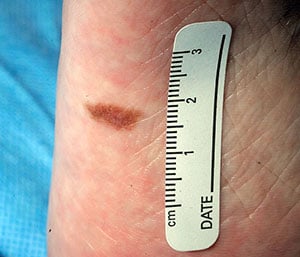Acral Lentiginous Melanoma Overview
Acral lentiginous melanoma is a relatively uncommon type of skin cancer that typically forms on the palms of the hands, on the soles of the feet or underneath the fingernails or toenails (most often on the thumb or big toe). The cancerous changes originate in the pigment-producing melanocytes, which are the cells that give the skin its color. The cancer gets its name from “acral,” the Greek word for “extremity,” and “lentiginous,” which means “freckled” and refers to the fact that melanoma spots are often darker than the surrounding skin.

Although acral lentiginous melanoma is the most common type of melanoma in people with dark skin, it occurs in people of all skin colors. After growing on the outer layer of skin or under a nail bed, the cancer can spread and become invasive if left untreated. Raised tumors tend to be more aggressive; however, even if a cancerous lesion appears flat on its surface, it can extend deep into the skin and underlying tissues.
Acral lentiginous melanoma causes and risk factors
Many experts believe that some people are genetically predisposed to developing acral lentiginous melanoma. However, researchers do not yet know exactly what causes it or how it can be prevented.
Unlike basal cell carcinoma, squamous cell carcinoma and other types of skin cancer, acral lentiginous melanoma has not been conclusively linked to exposure to sunlight or other forms of ultraviolet (UV) radiation. Indeed, it is difficult to get a sunburn or suntan on the palms of the hands or soles of the feet. The cancer does not have the genetic changes that typically originate from UV damage. In fact, its genetic makeup is unique. While approximately half of all skin-based melanomas have a BRAF mutation, that same mutation appears in less than 20% of all acral lentiginous melanomas.
Acral lentiginous melanoma signs and symptoms

The warning signs of acral lentiginous melanoma can include:
- A new, darkened streak in a fingernail or toenail that did not develop immediately after direct trauma, such as accidentally hitting the nail with a hammer, especially if it grows sideways or faster than the nail itself is growing
- A dark, narrow stripe that runs from the cuticle to the tip of a fingernail or toenail and has caused the nail to crack or break
- Changes in the size, shape, color or texture of an existing mole on a hand or foot, such as pigmentation or dark color that spreads from under the fingernail or toenail to the surrounding normal skin alongside the nail
- A new lesion on a hand or foot that is asymmetrical, has uneven coloring or borders, is larger than 6 millimeters in diameter or is changing in size, shape or color
- A lesion that resembles a bruise or stain
- An elevated, thickened patch of skin on the palm of a hand or the sole of a foot
Most acral lentiginous melanoma spots are black or dark brown, but some are lightly colored with shades of red, orange, pink, gray or tan, while others are completely colorless. As a lesion grows, it may become increasingly irregular in color or shape. In some cases, a melanoma spot on the bottom of the foot may be painful to walk on and mistaken for a plantar wart.
Acral lentiginous melanoma diagnosis
All forms of melanoma, including acral lentiginous melanoma, require prompt medical attention. An early diagnosis is the key to achieving the best possible outcome and quality of life. Therefore, routinely examining the skin and nails for unusual changes can be lifesaving. It is especially important to check the palms of the hands and the soles of the feet, which some people tend to overlook when examining their skin.
A conclusive diagnosis of acral lentiginous melanoma requires a biopsy, and a narrow margin excisional biopsy is ideal when possible. However, in most cases, a partial biopsy is the quickest and easiest way to establish the diagnosis. During this procedure, part or all of the suspicious lesion along with a small amount of surrounding healthy tissue are surgically removed. The tissues are then sent to a lab, where they are examined under a microscope by a dermatopathologist who can detect cancerous cells.
Acral lentiginous melanoma treatment
When diagnosed in its early stages, acral lentiginous melanoma can often be effectively treated and often cured. Treatment can vary based on the extent and depth of the cancer. The most common approach involves surgery to remove the cancerous lesion along with a slim margin of surrounding healthy skin. This procedure may be performed as part of the diagnostic process. Because acral lentiginous melanoma can develop in sensitive and difficult-to-reach areas of the body, it is important to work with an experienced specialist who will take steps to preserve the appearance of the skin and prevent the cancer from returning.
To address acral lentiginous melanoma that has spread to other tissues and organs, a combination of therapies may be considered, including:
- Immunotherapy
- Radiation therapy
- Targeted therapy
- Chemotherapy
The Moffitt Cancer Center difference
Because acral lentiginous melanoma is so rare, it is one of the least-researched types of cancer. Therefore, it is essential to seek treatment at a high-volume cancer center such as Moffitt, that is leading groundbreaking research. Moffitt Cancer Center is proud to have established one of the foremost melanoma programs in Florida and an active research program investigating acral lentiginous melanoma. Many patients entrust their care to our Cutaneous Oncology Program, which is led by world-class physician-researchers. Working together, these highly focused specialists are leading the way in investigating new prevention strategies and developing new treatments for all forms of melanoma.
If you have been diagnosed with acral lentiginous melanoma or any form of skin cancer and would like an appointment in our Cutaneous Oncology Clinic, you can request an appointment by calling 813-745-3980 or submitting a new patient registration form online. Additionally, if you have already been diagnosed with melanoma and would like a second opinion, we will be pleased to review your lab work, biopsy and imaging scans. As a new patient, you can feel confident that we will connect you with a cancer expert promptly, and you will hear back from one of us as soon as possible, regardless of where you are on your cancer journey. You do not need a referral to visit Moffitt.
Types
